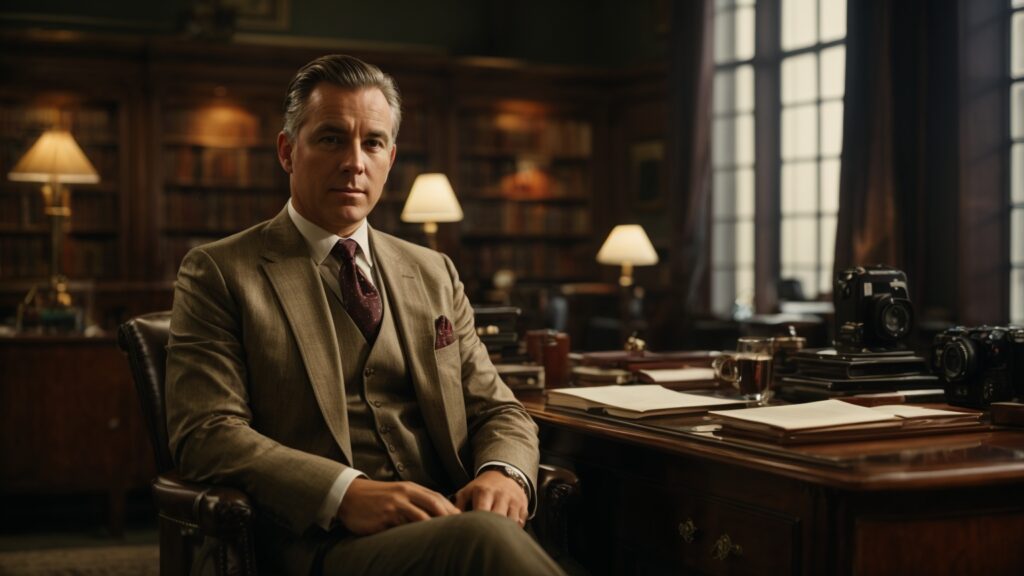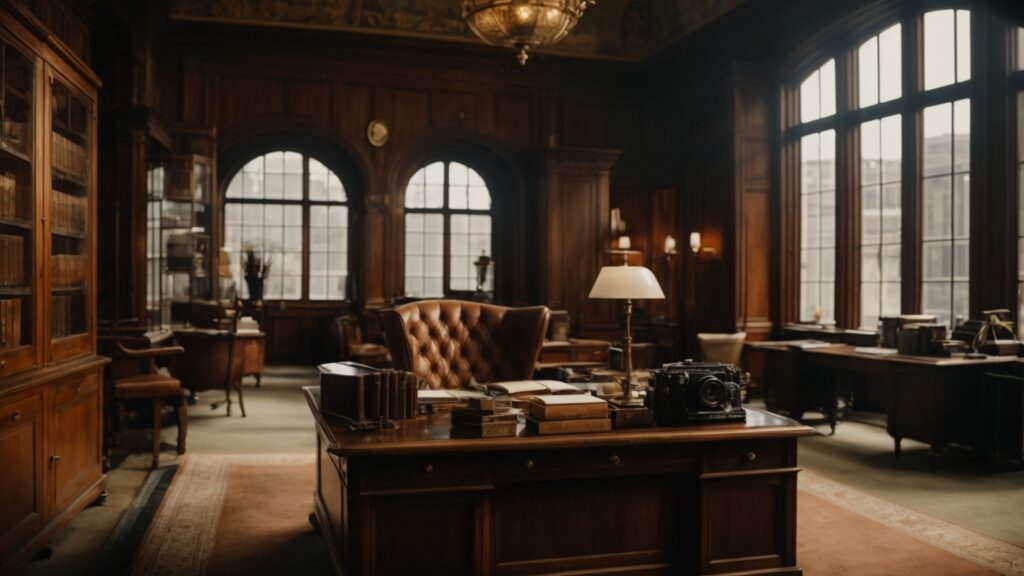Estimated reading time: 16 minutes
Introduction
The traditional English office, known for its timeless charm and functionality, remains a coveted design choice for both historical and modern workspaces. This office style, with its dark wood furniture and rich color schemes, elegantly combines the sophistication of English country office and study designs with the requirements of contemporary business environments. Such spaces not only echo the grandeur of period homes but also cater to modern needs, allowing for a seamless blend of tradition and innovation.
In the design of traditional offices and studies, interior designers and architects around the world emphasize the importance of maintaining a balance between aesthetic appeal and practical utility. Incorporating modern technology in classic furniture, such as desks and bookcases equipped with hidden wiring solutions, exemplifies how traditional spaces can meet today’s work space needs without sacrificing style. Furthermore, elements like ornate lighting fixtures and decorative pieces enhance the professional atmosphere, while comfortable seating and strategically placed art can add personality to your home office, making it both inviting and efficient. These design choices reflect a deep appreciation for heritage, coupled with an understanding of the modern professional’s needs, making the traditional English office a model of design excellence.
Key Takeaways
- Embrace Timeless Elegance: Add classic sophistication to modern workspaces by incorporating traditional English office features like rich wood paneling and ornate details.
- Blend Old and New: Seamlessly integrate modern office technologies within traditional furniture for a functional and aesthetically pleasing environment.
- Incorporate Comfort with Professionalism: Enhance your office atmosphere by adding homely comforts that combine the best home office design with professional productivity.
- Customize Your Space: Personalize your traditional English office with unique home office ideas, colorful artwork, and gallery walls to reflect your style.
- Consider Layout and Functionality: Optimize workflow in modern offices by using traditional elements like paneled dividers or classic bookcases to define work areas.
- Maximize Natural Light and Views: Emulate traditional English offices by incorporating large windows and elegant treatments to improve work environments with natural light and views.
- Mix and Match Styles: Create a unique office space by blending traditional elements with diverse styles like mid-century modern or contemporary.
- Consult with Professionals: Achieve a cohesive traditional-modern office design by consulting interior designers for expert insights and effective blending of styles.
The Timeless Appeal of Traditional English Office Designs
The Traditional English Office, known for its enduring popularity, epitomizes a blend of history, elegance, and function. This design style, characterized by elements like wood paneling and ornate details, has stood the test of time, offering a unique blend of comfort and professionalism. It is not just an aesthetic choice but a nod to a rich heritage that continues to influence modern and home office design ideas.
Case Study: Consider the example of a well-known English law firm’s headquarters, which has preserved its classic design while adapting to contemporary needs. This space exemplifies how traditional elements like mahogany desks, leather-bound books, and paneled walls can coexist with modern technology, creating an impressive and functional workspace.
Historical Significance of Traditional Designs
The historical significance of traditional English office designs extends beyond aesthetics, encompassing the vital aspect of fostering employee engagement and productivity. Companies that prioritize designer engagement and cultivate supportive work environments tend to outperform competitors. Research by McKinsey & Company indicates that organizations with highly engaged employees, including designers, enjoy a 21% increase in profitability compared to those with low engagement levels.
Moreover, designers thrive in collaborative settings where feedback and recognition are prevalent. According to an InVision survey, 97% of designers emphasize the importance of collaboration for producing their best work, while 85% value constructive feedback for personal growth and improvement. In essence, traditional English office designs, with their intricate details and timeless charm, serve as more than just architectural features—they serve as catalysts for fostering a culture of engagement, innovation, and excellence within the workspace.
Critical Elements of Traditional English Office Style
- Dark Wood Furniture: Conveys solidity and time-honored elegance.
- Rich Color Schemes: Often feature deep greens, blues, and burgundies for a luxurious feel.
- Elegant Decorative Pieces: Such as antique paintings, classic book collections, and ornamental lamps.
- Textured Wallpapers and Fabrics: Brocades and velvets that add depth and warmth.
- Heavy Drapery: Often in luxurious fabrics, lending a sense of grandeur.
- Brass and Leather Accents: Enhancing the luxurious and traditional ambiance.
- Ornate Lighting Fixtures: Chandeliers or vintage desk lamps for a classic touch.
Characteristic features of the traditional English office include dark wood furniture, rich color schemes, and elegant decorative pieces. These elements create an atmosphere of refined taste and sophistication, stating the values and identity of the individuals or organizations inhabiting these spaces.
The Psychological Impact of Traditional Designs in Workspaces
Traditional designs have a significant psychological impact on workspaces. They create an environment that enhances productivity and well-being, offering a sense of stability and continuity that can be comforting in modern business’s often fast-paced and transient world.
The timeless appeal of traditional English office designs lies in their ability to blend the past’s charm with the present’s functionality. They offer a workspace that is aesthetically pleasing, rich in history, and conducive to productivity, making them a relevant choice for today’s diverse office needs.

Blending Classic Style with Modern Functionality
In the quest for the perfect blend of style and functionality within the home, particularly within a workspace, integrating classic style with modern functionality becomes essential. The art of modern traditional craftsman rustic French or Scandinavian traditional designs in office and study design ideas enriches the aesthetic as well as the practicality of a workspace. Through platforms such as 1stdibs, homeowners can find inspiration and unique pieces that harmonize mid-century modern minimalist modern sensibilities with timeless design cues. This approach ensures that whether you are refurbishing a townhouse, setting up an apartment office and study, or converting a basement with history into a productive area, every element from office furniture to home decor marries modern arts and crafts seamlessly with established design conventions.
For those investigating best home office ideas, exploring galleries of office and study photos can provide invaluable insight. Discovering how 23 traditional home office set-ups are being reimagined through traditional transitional office and study design perspectives, or how 65 home office ideas incorporate elements of rustic modern design, can ignite inspiration. Even within compact spaces, the principles of contemporary office and study design demonstrate how well thought-out layouts and choice pieces can make a significant difference. This approach not only elevates the aesthetics of a space like a mid-century modern traditional craftsman rustic environment but also enhances functionality, proving that even in the realm of home office ideas, there’s a beautiful blend of the classic charm with modern-day requirements.
Innovative Design Solutions
Modern technology can be seamlessly incorporated into traditional settings through innovative design solutions. Here’s a table showcasing some examples:
| Traditional Element | Modern Innovation | Description |
|---|---|---|
| Mahogany Desks | Hidden Wiring Solutions | Preserving the classic look while accommodating modern electronic needs. |
| Ornate Lighting | Smart Lighting Systems | Enhancing the ambiance with adjustable, energy-efficient lighting. |
| Classic Seating | Ergonomic Chairs Styled Traditionally | Combining comfort and health benefits with a traditional aesthetic. |
| Bookshelves | Integrated Digital Displays | Blending digital convenience with the charm of classic bookcases. |
| Decorative Pieces | Multi-functional Decor | Items that serve both as decor and practical office tools. |
These innovations allow for a blend where modern office conveniences enhance the classic ambiance without overpowering it.
Balancing Aesthetics and Practicality
Achieving a balance between aesthetics and practicality involves choosing elements that respect traditional design while serving modern needs. This balance is found in modular furniture reflecting traditional styles, adjustable lighting for various tasks, and functional yet decorative pieces, ensuring every element serves aesthetic and practical purposes.
A leading interior designer, specializing in the fusion of traditional and modern designs, states: “The art of blending classic style with modern functionality is in the details. It’s about honoring the past while embracing the present, creating spaces that are as beautiful as they are functional.”
Merging the old with the new in-office design is a delicate, yet rewarding task. It demands an appreciation for traditional aesthetics, an understanding of modern necessities, and a creative approach to integration. The outcome is a workspace that not only pays homage to its heritage but also offers a comfortable, efficient environment for its users.

Designing Individual Offices: A Nod to Tradition
The shift towards individual offices in modern workspaces is a nod to traditional design, reflecting a blend of personalization and privacy. This trend, influenced by concepts like the traditional home office and office design, emphasizes the importance of creating spaces that are both individually tailored and steeped in classic aesthetics. It’s about marrying personal comfort with the elegance and formality of traditional English style.
The Benefits of Individual Offices
Individual offices offer numerous advantages, particularly in terms of productivity and privacy. They provide a personalized workspace free from the typical distractions of open-plan designs, allowing for greater focus and efficiency. Additionally, these offices offer privacy for confidential work or sensitive conversations, a key consideration in many professional settings.
Design Tips for Creating Timeless Individual Offices
When designing individual offices with a traditional English flair, consider the following tips:
- Select Classic Furniture: Opt for pieces like a mahogany desk or a leather armchair that echo traditional aesthetics.
- Incorporate Personal Elements: Personalize with items like bookshelves filled with favorite books or a gallery wall showcasing personal achievements or art.
- Use Rich Color Schemes: Employ color palettes that reflect traditional office styles, such as deep blues or greens, complemented by pops of color for a modern twist.
- Prioritize Comfort: Ensure the office is stylish and comfortable, with ergonomic furniture and adequate lighting.
- Blend in Modern Amenities: Seamlessly integrate modern technology while maintaining the traditional look, like hiding modern wiring in classic desks or using traditional-looking lamps with modern lighting capabilities.
Case Study: An example of this successful blend is a lawyer’s office in a historic London building. The space beautifully combines a traditional desk and bookcases with modern technology and personalized decor, creating a workspace that is both functional and steeped in tradition.
Designing individual offices with a traditional English style involves a thoughtful blend of classic aesthetics and modern functionality. By focusing on personalization, comfort, and integrating modern amenities, these spaces can offer the best of both worlds – a nod to tradition while catering to contemporary work needs.
The Influence of American Style on English Office Design
The American style has significantly influenced English office design, bringing a fresh and vibrant approach to traditional spaces. Designers are incorporating elements of eclectic mid-century modern and contemporary eclectic styles to add personality to home offices. By studying photos from top interior designers and architects worldwide, English designers have been inspired to create open-plan layouts with pieces of furniture like upcycled furniture and white cabinets. The eclectic maximalist approach seen in American design, such as the Brooklyn Heights townhouse, has also influenced English offices, incorporating art nouveau contemporary elements beyond the landscape. This fusion of styles has resulted in a unique and dynamic look for English office spaces.
A Comparative Analysis of English and American Office Designs
English office design traditionally emphasizes dark wood furniture, rich textures, and elaborate details, conveying a sense of history and formality. In contrast, American office design often leans towards minimalist and contemporary styles, focusing on open spaces, functionality, and modern furniture. The blending of these styles creates a unique workspace that combines the best of both worlds – the elegance of English design with the practicality of American style.
An expert in office design notes, “The merging of American functionality with traditional English elegance has revolutionized office interiors, offering designs that are both aesthetically pleasing and highly functional.”
Case Study: An example of this trend can be seen in a London-based architecture firm, where the office design incorporates sleek, modern American elements alongside classic English features. The space showcases minimalist desks and ergonomic chairs against a backdrop of traditional paneled walls and ornate bookshelves, illustrating a successful fusion of the two styles.
The influence of American style on traditional English office design has led to a new era of office aesthetics, where modernity meets tradition. This blend not only enhances the visual appeal of workspaces but also improves their functionality, catering to the diverse needs of today’s businesses. It’s a testament to how cross-cultural influences can lead to innovative and practical design solutions.
Incorporating Home Elements for a Comfortable Workspace
The growing trend of incorporating home-like comforts into office environments reflects a shift in how we view our workspaces. Today’s office design is increasingly inspired by home office ideas, blending the comfort and personalization of the home with the functionality of a traditional office. This approach aims to create spaces that facilitate productivity and promote well-being and job satisfaction.
The Rise of the Home Office
The rise of the home office, particularly accelerated by the recent increase in remote working, has significantly influenced commercial office designs. Employers are now seeking to replicate the comfort and personalization of a home office in traditional workspaces. This shift acknowledges that a comfortable and inviting work environment can significantly enhance productivity and employee satisfaction.
Integrating Homely Comforts into Office Spaces
Integrating homely comforts into office spaces can significantly enhance the overall ambiance and employee satisfaction. To achieve this, consider adding soft furnishings such as plush sofas, armchairs, or decorative pillows, which provide a cozy and comfortable touch. Encourage employees to personalize their workspace with personal decor like photos, plants, or other personal items, fostering a sense of ownership and comfort. Flexible lighting options, such as using lamps and adjustable lighting, can create a warm and inviting atmosphere, essential for a pleasant work environment.
Additionally, designing relaxed work areas, like a coffee corner or a reading nook, can offer spaces for informal meetings or relaxation, breaking the monotony of a traditional office setup and promoting a more collaborative and stress-free environment.
Homely Design Elements
- Comfortable Seating
- Personalized Workstations
- Decorative Plants
- Ambient Lighting
- Relaxation Zones
Comparing Home and Office Design Elements
| Home Element | Office Adaptation | Benefit |
|---|---|---|
| Plush Armchairs | Ergonomic Lounge Chairs | Comfort and relaxation |
| Decorative Pillows | Branded Cushions | Personal touch and branding |
| Personal Photos | Desk Photo Frames | Personalization of workspace |
| Reading Lamp | Adjustable Desk Lamps | Flexible and ambient lighting |
| Coffee Corner | Office Pantry with Seating | Informal collaboration space |
An interior designer specializing in blending home and office elements shares, “Incorporating homely comforts into office spaces not only enhances the aesthetic but also positively impacts employee morale and productivity.”
Infusing home elements into office design creates a more comfortable, personalized, and engaging work environment. By adopting features typically found in home offices, businesses can foster a workspace that promotes efficiency and supports the well-being and satisfaction of their employees.

- Desk Organizer Tray
- 5 Division
- Jewelry Storage
Conclusion
As we reflect on the traditional English office, its seamless integration of classic aesthetics and modern functionality highlights a successful fusion of past and present. This style, deeply rooted in interior design principles, effectively blends the dark paint of traditional woodwork with modern conveniences to create spaces that are both functional and visually striking. It’s this thoughtful combination that has proven to improve workplace efficiency and aesthetic appeal, making traditional office and study designs a favored choice across various settings, from family home office and study to corporate boardrooms.
The adoption of elements like beam ceilings and decorative art deco features in traditional English office environments encourages a sense of history and continuity, which is especially appealing in rustic office and study settings. The ability to combine traditional charm with contemporary needs—such as open plan layouts that foster collaboration while respecting personal space—demonstrates a dynamic adaptability that resonates with both interior designers and architects around the world. This enduring appeal ensures that the traditional English office remains relevant and cherished in today’s ever-evolving workspace landscape.
James Dunnington leads the James Dunnington Collection, featuring five unique blogs: a practical Pet Care Guide, an enlightening Ancient History Blog, a resourceful Home Improvement Guide, a cutting-edge Tech Innovation Guide, and a strategic Online Money Making platform. Each site delivers valuable insights designed to empower and inform. For updates and more tips, visit our Contact Us page to sign up for our newsletter, ensuring you never miss out on the latest content from any of these dynamic fields.

